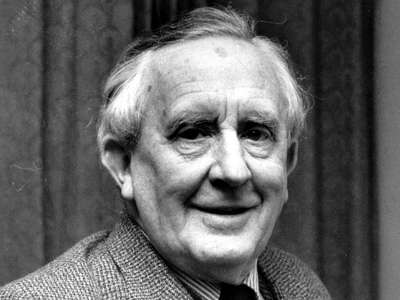“One Ring to Rule Them All,” even those not familiar with J.R.R. Tolkien’s works have at least once heard of the One Ring in Tolkien’s magnum opus, The Lord of the Rings. The Hobbit, The Lord of the Rings, The Silmarillion, and many other collections of his writings form what is called Tolkien’s Legendarium, a detailed historical account of a land called Middle-Earth, a mythic world vast with a genesis, thousands of years of history, and languages that define cultures (Hammond). This essay will seek to examine aspects of Tolkien’s life and the impacts they had on his Legendarium, the high fantasy that launched an entire genre.
John Ronald Reuel Tolkien was born January 3, 1892, in South Africa. Having moved to England at a young age, Tolkien lost both of his parents by 1904. Her mother, Mabel Tolkien, had converted to Catholicism four years prior to her death, and young Tolkien was heavily influenced by her devotion. As a result, Tolkien was raised by the Catholic Church upon becoming an orphan and maintained his religion for the rest of his life.
As a young boy, Tolkien showed great talent in linguistics, mastering Latin and Greek, and later attending Exeter College, Oxford where he studied Old and Middle English. In 1915, Tolkien enlisted to the British Army to fight in WWI. He fought in the trenches in the Somme offensive and was relieved of his service after a serious infection. Upon his recovery and return to academia, Tolkien was offered professorship at the University of Oxford as the Professor of Old English.
It was around this time that Tolkien began writing his first book, The Hobbit (1937), and The Lord of the Rings were published subsequently in 1953-1954. While criticism for his books were widely varied within academia, the general public fell in love with his work, and Tolkien amassed a large fandom, which lasts even today. Tolkien continued to expand his Legendarium throughout his adult life and wrote until his death on September 2, 1973 (Hammond). While there were various aspects of Tolkien’s life experiences that enriched the fictitious world of Middle-Earth, his faith, love for historical languages, and military career produced heavy influences on his works.
First, Tolkien’s Legendarium was deeply influenced by his Catholic faith. Tolkien was a devout Catholic who famously played a significant role in the conversion of his friend, C.S. Lewis and his wife Edith Tolkien(Hammond). According to the Tolkien scholar Joseph Pearce, The Lord of the Rings, has many ties to Tolkien’s Christian faith. The date of the destruction of the Ring, for example, is March 25, a significant date in the Christian calendar as it is The Feast of Annunciation—the date of the Incarnation and the Crucifixion. The Christian belief that Christ’s Incarnation and Crucifixion were necessary in human redemption is tied to the narrative where Frodo, the Ring-Bearer, destroys the sin of the world for the hope of humanity on the same day.
The parallels between Mordor/Death and Mount Doom/Golgotha are also apparent. Other character arcs, such as Aragorn’s return as the King and Gandalf’s fall and resurrection were also drawn from his religious background (Drout). The correlation between his faith and his magnum opus is clear through the subtle themes, character arcs, and allegories throughout Tolkien’s works.
Secondly, the history of Middle-Earth and its backbones were the result of Tolkien’s mastery of philology, a study of the history of languages. During his time as a young scholar, Tolkien became inspired by one specific couplet from an Old English poem, Crist of Cynewulf, which read:
Eálá Earendel engla beorhtast
Ofer middangeard monnum sended
Which translates as:
Hail Earendel brightest of angels,
over Middle Earth sent to men. (Doughan)
This inception led to what became the creation of today’s beloved high fantasy. As a student and professor, Tolkien studied the Classics, Old English, Gaelic, Welsh, and Finnish which all played its part in the creation of the dozens of languages spoken by the people of Middle-Earth. Quenya and Sindarin, for example, have enough words and grammar to be considered a functional language.
Tolkien fashioned his languages with great care. He believed that there are languages that are more intrinsically attractive and those that are repulsive. It is said that Tolkien based Quenya, the High Elven language, from Welsh and Finnish, which he considered to be more intrinsically beautiful (Shippey). Also, as the Professor of Old English at Oxford, Tolkien was an authoritative scholar that left behind other notable works such as “Beowulf, the Monsters and the Critics,” and Sir Gawain and the Green Knight, exemplifying his love for historical epics.
Tolkien understood very well how languages change over time and how epics such as Beowulf are passed down orally. As a result, in the Third Age of Middle-Earth, it is the dialect Sindarin, that is more commonly spoken as opposed to Quenya, which was used more widely in earlier ages (Doughan). Tolkien’s understanding and mastery of the history of languages give the myths of Middle-Earth a life-like mythic reality, drawing the readers closer to his world.
Finally, Tolkien’s military life affected the character developments in his stories. Tolkien knew, firsthand, the aftermaths of war and how it changes the individual as he lost a few of his best friends in the war. The post-traumatic symptoms Tolkien experienced are reflected in the Ring-Bearer Frodo at the end of The Lord of the Rings. Frodo, having returned to the Shire after the War of the Rings, never comes to full recovery even after the war (Livingston). He says:
“‘Alas! There are some wounds that cannot be wholly cured,’ said Gandalf.…
…’There is no real going back…. Though I may come to the Shire, it will not seem the same; for I shall not be the same. I am wounded by knife, sting, and tooth, and a long burden. Where shall I find rest?’” (Tolkien, 967)
Frodo, once a cheerful hobbit of the Shire, returns home with burdens and wounds, discoloring the place he once loved. As a war veteran who experienced the hell of the trenches and losing his friends and health in the process, Tolkien shares this reflection through Frodo’s suffering that goes beyond the end of the war.
Tolkien is often credited as single-handedly creating the genre of high fantasy. It is said that Tolkien spent approximately 50 years creating the Legendarium. Though the Legendarium is a story of strange and unfamiliar peoples in a distant, fictitious land, Tolkien’s Legendarium resonates deeply within readers, as if its mythic nature has a glimmer of truth and realness to it.
While there are numerous details of Tolkien’s prose that add to the realness of his tales, Tolkien’s life as a Catholic, philologist, and war veteran are some key factors that heavily influenced his novels, adding to the richness of the world of Middle-Earth, and by doing so, encapsulating generations of worldwide readers.










